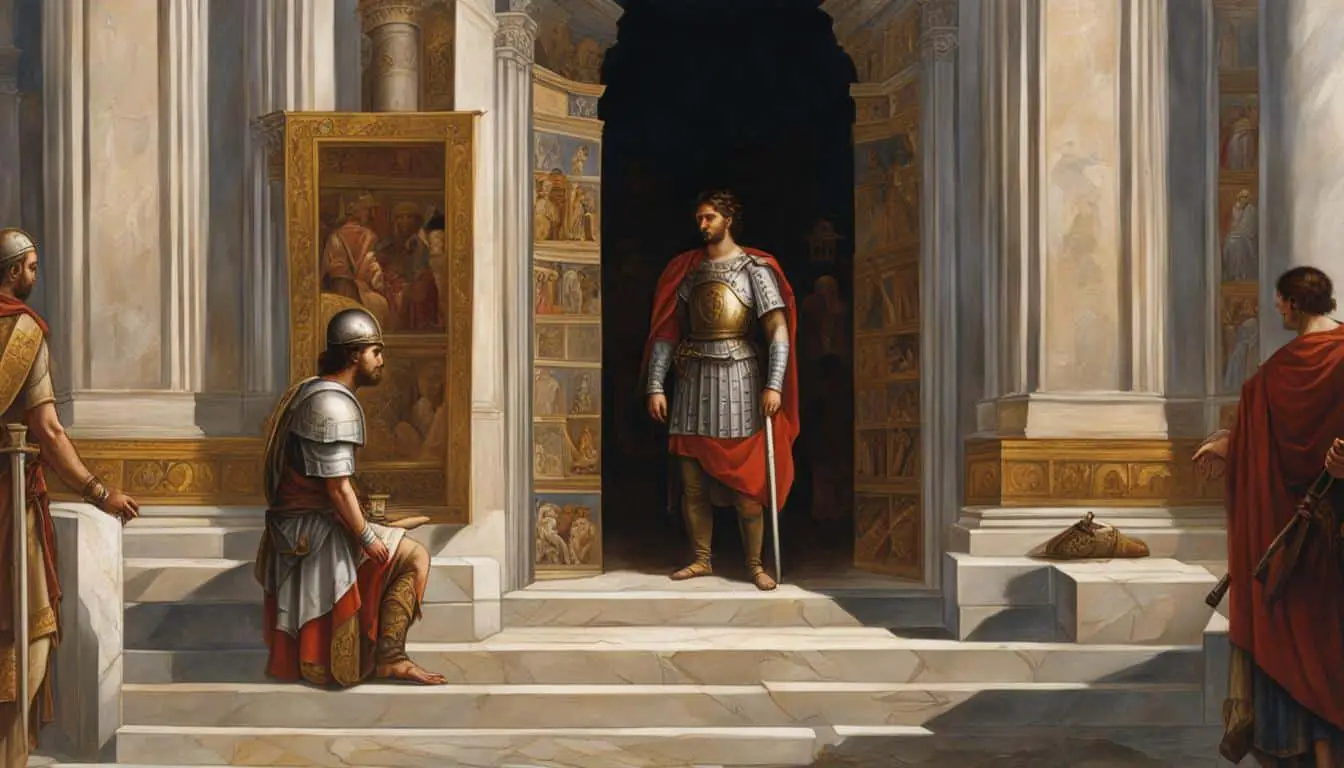
The Impact of Roman Culture on Early Christianity
The influence of Roman culture on the early development of Christianity cannot be underestimated. The efficient communication infrastructure and political unification of the Roman Empire played a crucial role in the spread of the teachings of Jesus Christ. Apostles like Paul traveled extensively across the empire, attracting both Jews and non-Jews to the teachings of Christianity.
As Christianity gradually moved away from strict Jewish laws, it began to establish itself as a separate religion, incorporating elements of Roman traditions and practices. However, this transition was not without challenges.
Early Christians faced misunderstanding and persecution, with their rituals often wrongly interpreted as acts of cannibalism and incest. Emperor Nero particularly targeted Christians as scapegoats and executed many publicly. Despite this, Nero’s persecution was short-lived and not replicated throughout the empire.
In fact, subsequent emperors exhibited more tolerant views towards Christianity. In 313 AD, Emperor Constantine issued the Edict of Milan, officially accepting Christianity and making it the official religion of the Roman Empire. This marked a significant turning point in the recognition and acceptance of Christianity within the Roman world.
Key Takeaways
- Roman culture played a significant role in the growth and development of early Christianity.
- The efficiency and communication infrastructure of the Roman Empire facilitated the spread of Christian teachings.
- Early Christians faced persecution and misunderstandings, but subsequent emperors adopted more tolerant views.
- Emperor Constantine’s conversion and the Edict of Milan marked a turning point in the recognition and acceptance of Christianity.
- The impact of Roman culture on early Christianity shaped its practices, beliefs, and ultimate spread across the Roman world.
Roman Rulers’ Relationship with Christianity as Marked by Their Coins
Rome, being initially a pagan kingdom, witnessed the rise of Christianity during the reign of Roman emperors. The relationship between these rulers and Christianity can be seen through the symbolism depicted on Roman coins. These symbols served as a powerful visual tool to communicate the emperors’ association and support for the new religion.
One notable example is the reign of Emperor Constantine, who played a pivotal role in the history of Christianity. After having a vision of Jesus, Constantine legalized Christianity and promoted religious tolerance through the Edict of Milan in 313 AD. As a result, coins minted during his reign often feature crosses and other religious imagery, reflecting his embrace of Christianity as a significant influence on his rule.
“No longer should we offer sacrifices to lifeless idols, but rather to the living God, who truly reigns.”
The influence of Christianity on Roman coinage continued in the Byzantine Empire. Christograms—monograms symbolizing Jesus Christ—and images representing the Christian faith were prominently featured on coins. These symbols served as a testament to the enduring impact of Christianity on the rulers and their desire to display their allegiance to the faith.
| Roman Emperor | Christian Symbol |
|---|---|
| Constantine I | |
| Justinian I |  |
| Theodosius I |  |
During the reign of Theodosius, the last emperor before the split of the Roman Empire, Christianity became the official religion through the Edict of Thessalonica in 380 AD. This further solidified the close connection between Roman rulers and Christianity, as depicted by the Christian symbols on coins minted during this time.
Spread of Christianity in the Roman Empire
The spread of Christianity in the Roman Empire was greatly facilitated by the empire’s extensive political unification and efficient road system. The empire’s vast territory provided a network of roads and communication infrastructure that allowed the message of Christianity to reach far and wide. Missionaries played a crucial role in the spread of Christianity, but it was the everyday Christians who truly made a difference by sharing their faith with others.
Christianity coexisted with pagan practices in the Roman Empire, and many people viewed it as compatible with their existing beliefs. This inclusive nature of Christianity attracted individuals from various regions and religious backgrounds, contributing to its rapid growth. Additionally, the translation of Christian texts into Greek made them accessible to a wider audience within the empire.
Despite sporadic and regional persecution of Christians, the spread of Christianity continued to thrive. The middle of the third century witnessed intensified persecution, but it was Emperor Constantine’s conversion to Christianity and the issuance of the Edict of Milan in 313 AD that marked a significant turning point. This edict granted religious tolerance and officially recognized Christianity, leading to its widespread acceptance within the empire.
The Role of Missionaries
Missionaries played a vital role in spreading Christianity throughout the Roman Empire. Figures like the Apostle Paul traveled extensively, establishing communities of believers and spreading the teachings of Jesus. Paul’s journeys took him to major cities such as Rome, Ephesus, and Corinth, where he preached and converted many individuals to Christianity.
However, it is important to note that the spread of Christianity was not solely reliant on missionaries. Everyday Christians also played a significant part in the growth of the faith. Through their interactions with family, friends, and colleagues, they shared their beliefs and values, ultimately influencing others to embrace Christianity.
| Key Figures | Impact |
|---|---|
| Apostle Paul | Established communities, spread teachings |
| Everyday Christians | Shared beliefs, influenced others |
Overall, the spread of Christianity in the Roman Empire was a result of the combined efforts of missionaries and everyday Christians, who effectively communicated the message of the faith. The empire’s political unification and road system provided the framework for this diffusion, while the acceptance of Christianity by Emperor Constantine solidified its prominence within the empire.
Conclusion
The impact of Roman culture on the growth of Christianity was profound. The efficiency and infrastructure of the Roman Empire played a significant role in facilitating the spread of Christian teachings and principles. Apostles like Paul traveled extensively throughout the empire, sharing the teachings of Jesus with both Jews and non-Jews.
As Christianity attracted non-Jewish members, it gradually moved away from strict Jewish laws and became a separate religion. However, early Christians faced persecution and were often misunderstood. Some of their rituals, such as the Eucharist, were wrongly interpreted as cannibalism and incest.
Despite these challenges, the Roman Empire’s influence on Christianity cannot be overstated. Emperor Constantine’s conversion to Christianity marked a significant turning point. With the official recognition and subsequent promotion of Christianity by the imperial government, the religion gained dominance in Rome and the regions formerly ruled by the Roman Empire.
Thus, the impact of Roman culture on early Christianity shaped its practices, beliefs, and ultimate spread across the Roman world. The efficient infrastructure of the Roman Empire, the gradual acceptance of non-Jewish members, and the imperial endorsement of Christianity all contributed to its significant growth within the Roman world.
FAQ
How did the efficiency and communication infrastructure of the Roman Empire facilitate the spread of Christianity?
The Roman Empire’s extensive political unification and road system provided a conducive environment for the spread of Christian teachings and principles. Everyday Christians talking to others played a significant role in spreading the faith.
What role did the Apostles, like Paul, play in spreading Christianity?
Apostles like Paul traveled extensively across the empire, spreading the teachings of Jesus to both Jews and non-Jews. Their efforts played a crucial role in the early dissemination of Christianity.
How did Christianity become a separate religion from Judaism?
Christianity gradually moved away from strict Jewish laws, attracting non-Jewish members and becoming a distinct religion. This shift in focus led to the establishment of Christianity as a separate faith.
Did early Christians face persecution?
Yes, early Christians faced persecution and were often misunderstood. Some of their rituals were wrongly interpreted as cannibalism and incest, leading to mistrust and persecution by authorities.
Who was responsible for the persecution of Christians?
Emperor Nero targeted Christians as scapegoats and executed many of them publicly. However, Nero’s persecution was short-lived and not replicated throughout the empire, with subsequent emperors adopting more tolerant views towards Christianity.
When did Christianity gain official recognition in the Roman Empire?
In 313 AD, Emperor Constantine issued the Edict of Milan, officially accepting Christianity and making it the official religion of the Roman Empire.
Were there any symbols on Roman coins that represented Christianity?
Yes, symbols on Roman coins played a significant role in communicating the rulers’ relationship with Christianity. Roman emperors used crosses and religious imagery on their coins, reflecting their association with Christianity.
How did Roman rulers promote and legalize Christianity?
Emperor Constantine, after a vision from Jesus, legalized Christianity and promoted religious tolerance through the Edict of Milan in 313 AD. Later, Emperor Theodosius made Nicene Christianity the official religion through the Edict of Thessalonica in 380 AD.
How did the Roman Empire’s culture impact the growth of Christianity?
Roman culture had a profound impact on the growth and development of Christianity. The translation of Christian texts into Greek made them accessible to a wider audience in the empire, and the inclusive nature of Christianity attracted people from various regions and religious backgrounds.
How did the spread of Christianity coexist with pagan practices?
Christianity coexisted with pagan practices, and many viewed it as compatible with their existing beliefs. This allowed Christianity to gain traction among the Roman population and expand its influence.
What ultimately led to the dominance of Christianity in Rome and the formerly Roman-ruled regions?
The legalization and subsequent promotion of Christianity by the imperial government, starting with Emperor Constantine, led to its dominance in Rome and the regions formerly ruled by the Roman Empire.
What was the influence of Roman culture on Christianity’s growth?
The impact of Roman culture on early Christianity cannot be overstated, as it shaped its practices, beliefs, and ultimate spread across the Roman world.
